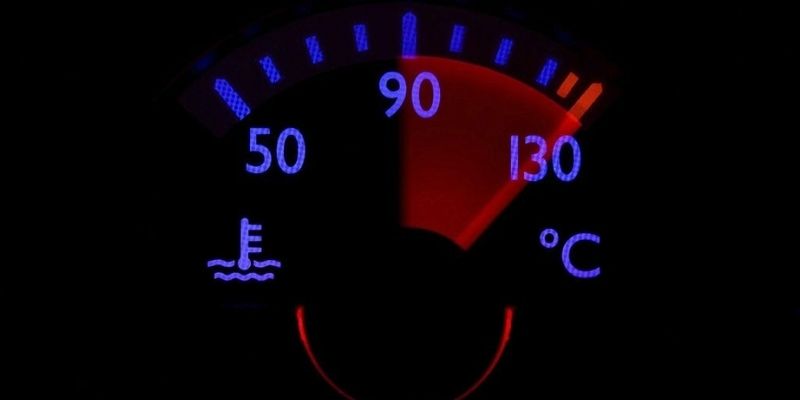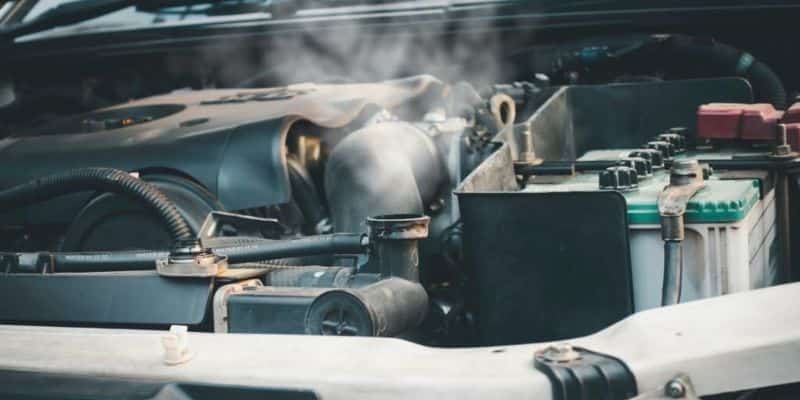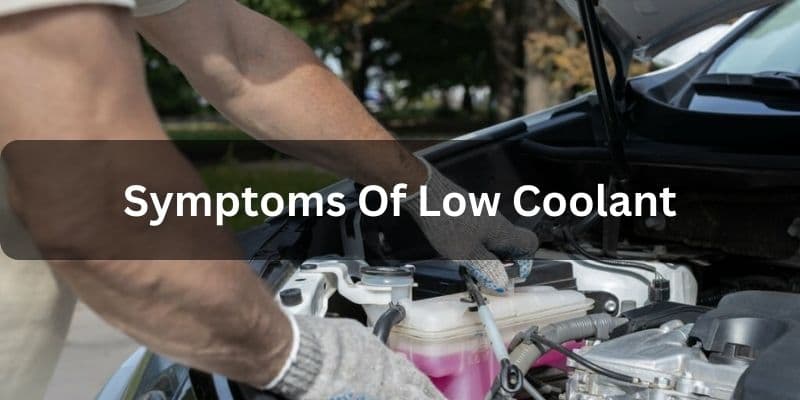Coolant, also known as antifreeze, acts as a protector for your engine that ensures everything runs smoothly. It plays a vital role in maintaining the right engine temperature and protecting essential parts. Besides maintaining the engine temperature it also protects your engine from rust, improves lubrication, and helps the water pump work efficiently.
In this article, we’ll explore the importance of coolant in your car, how it values your engine, and what damages it can bring if the coolant level is low in your engine.
Additionally, you will get to know the benefits of coolant on engine life, performance, and drive. Moreover, we will mainly explore the symptoms of low coolant levels in your car engine and how to fix them properly to save the engine from damage.
Before diving into the symptoms of low antifreeze in your car engine, let’s explore the importance of coolant on the engine and how it benefits the car’s performance.
What Does Engine Coolant Do?
Coolant, or antifreeze, offers a range of benefits to your engine’s health and life. Here are some key points on the purpose of coolant and what coolant is used for in engine radiators:
- Temperature Regulation: Coolant helps maintain the engine at an optimal operating temperature, preventing it from getting too hot or too cold. This ensures that your engine runs efficiently and avoids the risk of overheating.
- Corrosion Prevention: Coolant contains additives that protect the engine’s components from corrosion and rust. Over time, this corrosion protection extends the lifespan of vital parts like the radiator, water pump, and engine block.
- Lubrication Enhancement: In some engines, coolant serves a dual purpose by acting as a lubricant for the water pump. This reduces friction and wear, helping the pump operate smoothly and efficiently.
- Freezing and Boiling Point Control: Coolant has a lower freezing point and a higher boiling point than water, making it suitable for various weather conditions. This prevents the coolant from freezing in cold temperatures and boiling over in hot conditions, both of which can damage the engine.
- Cavitation Prevention: Rapid temperature changes in the cooling system can lead to cavitation, where air bubbles form. Coolant contains additives to prevent cavitation, protecting the water pump and other components from potential damage.
In essence, coolant isn’t just an engine cooling fluid; it’s a protector for your engine. Its role in maintaining temperature, preventing corrosion, enhancing lubrication, and controlling freezing and boiling points ensures your engine’s longevity and reliable performance.
Symptoms of Low Coolant Levels in Engine
1. Engine Overheating
One of the most critical signs of low coolant is engine overheating. Your engine operates efficiently within a specific temperature range, and coolant plays a pivotal role in maintaining this balance. When coolant levels are insufficient, the engine can’t regulate its temperature effectively, leading to overheating.
As your engine runs, it generates a significant amount of heat. Coolant flows through the engine, absorbing this heat and carrying it away to the radiator, where it’s dissipated into the air. This process ensures that the engine stays within its safe temperature limits.
However, when coolant is low, this process is disrupted. The engine can’t shed heat efficiently, causing its temperature to rise rapidly. Engine Overheating can lead to severe damage, including warped cylinder heads and engine block cracks, which are costly to repair.
If you notice your temperature gauge rising toward the danger zone or your engine is emitting smoke, pull over immediately and allow the engine to cool.
Check your coolant level and add the right coolant if needed. Addressing low coolant levels promptly can prevent further damage and keep your engine running smoothly.
2. Rapid Temperature Fluctuations
Rapid temperature fluctuations are another sign of lower coolant within the engine. Your vehicle’s engine is designed to operate within a specific temperature range to ensure optimal performance and engine life. Coolant is the crucial component responsible for maintaining this delicate balance.
When coolant levels are too low, the engine’s ability to regulate its temperature becomes compromised. As a result, you may observe the temperature gauge bouncing between extremes or rapidly rising and falling.
These fluctuations are clear indicators that your engine is struggling to maintain the correct operating temperature.

Rapid temperature swings can have detrimental effects on your engine’s performance and overall health. They can lead to inefficient combustion, decreased fuel efficiency, and increased emissions. Additionally, these fluctuations can put additional stress on engine components, potentially causing premature wear and tear.
If you notice these erratic temperature changes, it’s essential to address the issue promptly. Begin by checking your coolant levels and topping up if necessary.
Additionally, have your cooling system inspected for leaks or other problems that may be contributing to the fluctuations. By taking action early, you can help preserve your engine’s performance and prevent costly repairs down the road.
3. Low Coolant Level Warning Light
Modern vehicles are equipped with low coolant warning lights and these warning signs are early indications of coolant leaks. When this light illuminates, it’s a direct indication of a potential issue with your antifreeze level.
The coolant warning light typically resembles a thermometer or a dripping radiator. When it comes on, it signals that the engine is running hotter than it should due to low coolant. This warning should never be ignored, as it’s your vehicle’s way of alerting you to a potentially serious problem.
Ignoring the coolant warning can have dire consequences. If coolant levels remain low, the engine can overheat, leading to costly damage and repairs.
To address this warning, pull over in a safe location, allow the engine to cool, and check the coolant. If it’s low, top it up as needed and inspect for any leaks.
The coolant warning indicators serve as an invaluable early warning system, and heeding its alert can prevent severe engine damage.
4. Smoke from the Engine Compartment
The sight of smoke coming out from your vehicle’s engine compartment is an unmistakable sign that something is faulty. When this occurs, it can be a direct result of low antifreeze levels, which lead to engine overheating.
Low coolant levels can cause the engine to heat up excessively, resulting in the boiling of what little coolant remains. When this happens, the engine can emit steam or smoke, often accompanied by a pungent odor. It’s a clear signal that the engine is in distress and immediate attention is required.
Driving with smoke originating from the engine compartment is not advisable, as it can lead to further damage and costly repairs.
When you observe this symptom, it’s crucial to pull over safely, turn off the engine, and allow it to cool down. Once the engine has cooled, check the coolant and top it up if necessary.

Addressing the issue promptly not only prevents further engine damage but also ensures your safety on the road. Smoke from the engine compartment should never be ignored, as it’s a visible indicator of low antifreeze levels and potential overheating.
5. High-Temperature Gauge Reading
Your vehicle’s temperature gauge is like a health monitor for the engine, and when it consistently registers a higher-than-normal reading, it’s cause for concern. This elevated temperature reading is a sign of low coolant levels.
Coolant plays a pivotal role in regulating the engine’s temperature. When it’s in short supply, the engine struggles to maintain its ideal operating temperature, resulting in a gauge that indicates overheating. Ignoring this warning sign can lead to serious engine damage.
A high-temperature gauge reading is not something to take lightly. If you notice the gauge consistently in the red zone or significantly higher than usual, it’s essential to address the issue immediately. Pull over safely, turn off the engine, and allow it to cool down.
After the engine has cooled, check the coolant level and top it up if needed. Additionally, inspect for any signs of leaks or damage to the cooling system.
6. Check Engine Light
The “Check Engine” light on your dashboard is a universal symbol that something in your vehicle’s engine needs attention. Surprisingly, one of the reasons this light might illuminate is low engine coolant.
When your engine is running too hot due to inadequate coolant, it can trigger the “Check Engine” light. This is because the engine’s control module monitors various sensors, including those related to the coolant temperature.
When it detects abnormal temperature readings, it signals the “Check Engine” light to alert you to the issue.
While the “Check Engine” light can be triggered by various factors, ignoring it when accompanied by symptoms like overheating or high-temperature gauge readings can be risky. It’s essential to address this warning promptly.
To resolve the issue, first, pull over safely and allow the engine to cool down. Then, check the engine coolant and add more if necessary. If the “Check Engine” light persists, it’s advisable to have your vehicle inspected by a professional to rule out any other underlying problems.
Taking action when the “Check Engine” light illuminates due to low engine coolant can help prevent engine damage and ensure your vehicle continues to run smoothly.
7. Cold Air Blowing When Heat is On
When you notice cold air is blowing when heat is on from vents, it is a clear indication that something is wrong with the heater core.
It can be a cause of a clogged heater core or maybe some other fault with the heating sensor. This phenomenon occurs because there isn’t enough warm coolant circulating through the heater core to produce the desired heat.
When coolant levels are insufficient, the heater core doesn’t have an adequate supply of warm coolant to warm the air passing through it. As a result, you experience cold or lukewarm air blowing into the cabin, even when you’ve cranked up the heat.
Experiencing cold air when you expect warmth is not only uncomfortable but also indicates a problem within your vehicle’s cooling system. To fix this situation, check your coolant in the engine and add more if needed.
Additionally, have the cooling system inspected for any leaks or issues that may be contributing to the lack of warmth.
By addressing this symptom promptly, you can ensure that your vehicle’s heating system operates effectively and that you stay cozy during your drives in cold weather.
Fixes or Solutions for Low Coolant
A. Identifying the Coolant Leak
If you’ve determined that your vehicle is experiencing low coolant levels, the first step in resolving the issue is identifying the source of the leak. Coolant leaks can occur anywhere within the cooling system, and it’s essential to pinpoint the exact location to address the problem effectively.
Here’s a simple process to help you identify the coolant leak:
- Visual Inspection: Start by inspecting the engine bay and the ground beneath your vehicle for any visible signs of coolant leakage. Look for wet or damp areas, as well as any stains or puddles.
- Pressure Test: A cooling system pressure test can help pressurize the system to detect leaks more easily. This test is often performed by professionals but can also be done using a pressure tester kit available for purchase.
- Inspect Hoses and Connections: Check all coolant hoses, connections, and clamps for signs of wear, damage, or looseness. Tighten or replace components as needed.
- Radiator and Heater Core: Inspect the radiator and heater core for leaks or damage. These components are critical in the coolant circulation system.
- Coolant Reservoir: Examine the coolant reservoir for cracks or leaks. A damaged reservoir can lead to coolant loss.
Identifying and addressing the leak promptly is crucial to preventing further coolant loss and potential engine damage.
B. Topping Up Coolant
If you notice the low coolant in the radiator, the first thing is to fill up the coolant to the recommended level. Topping up the coolant is a primary task to fix the engine from overheating issues.
Here’s how to effectively top up your coolant:
- Engine Cool: Before adding coolant, ensure that the engine has cooled down. Attempting to add coolant to a hot engine can result in burns and is not recommended.
- Locate the Coolant Reservoir: Open your vehicle’s hood and locate the coolant reservoir. It’s typically a translucent plastic container with markings indicating the minimum and maximum coolant levels.
- Check the Coolant Type: Verify the type of coolant recommended for your vehicle. It’s important to use the correct coolant type to maintain the cooling system’s efficiency.
- Add Coolant: Slowly pour the coolant into the reservoir, being cautious not to overfill. Add coolant up to the maximum level marker or as specified in your vehicle’s owner’s manual.
- Bleed Air Bubbles: To ensure proper coolant circulation, you may need to bleed any trapped air bubbles from the system. Refer to your vehicle’s manual for specific instructions.
- Secure the radiator Cap: Close the coolant radiator cap securely.

Regularly checking and topping up your coolant levels is a simple but crucial maintenance task. It helps maintain the engine’s temperature, prevents overheating, and ensures your vehicle operates smoothly.
C. Addressing Damaged Components
In some cases, low engine coolant may be a result of damaged components within the cooling system. If you’ve identified and resolved leaks but continue to experience coolant loss, it’s essential to inspect and address any damaged parts or components. Here are key areas to focus on:
- Coolant Hoses: Check all coolant hoses for signs of wear, cracks, or damage. Over time, hoses can deteriorate, leading to coolant leaks. Replace any damaged hoses to prevent further coolant loss.
- Radiator: Examine the reservoir for leaks or damage, especially in areas where fins may be bent or corroded. A damaged coolant reservoir can result in coolant loss and overheating. Consider radiator repair or replacement if necessary.
- Water Pump: The water pump is responsible for circulating coolant through the engine. A malfunctioning water pump can lead to inadequate coolant circulation and subsequent overheating. Inspect the water pump for leaks or unusual noises and replace it if needed.
- Thermostat: A faulty thermostat can disrupt the engine’s cooling process. If the thermostat is stuck closed, it can cause overheating. Ensure that the thermostat is functioning correctly and replace it if it’s not.
- Coolant Reservoir: If the coolant reservoir itself is damaged or cracked, it can lead to coolant loss. Inspect the reservoir for any issues and replace it if necessary.
- Pressure Test: Consider performing a pressure test on the entire cooling system to identify any hidden leaks or weaknesses in components.
Addressing damaged components within the cooling system is crucial to maintaining proper coolant levels and preventing overheating.
How often should I check my coolant level?
To maintain your vehicle’s cooling system and prevent potential issues, it’s advisable to check your coolant level regularly. A good rule of thumb is to inspect it every month or before embarking on long journeys. However, consult your vehicle’s owner’s manual to find the best coolant for your old car or modern car, as maintenance intervals can vary.
In addition to regular checks, remain attentive to signs of low coolant levels, including dashboard warnings, unusual engine temperature readings, or reduced heater performance.
Can I use water as a temporary coolant substitute?
Yes, in an emergency situation, you can use water as a temporary coolant substitute, but it’s not a long-term solution. Water can help dissipate heat and prevent your engine from overheating temporarily. To use water as a substitute, follow these steps:
- Ensure the engine is cool before opening the radiator or coolant reservoir.
- Slowly add water to the radiator or reservoir until it reaches the appropriate level.
- Start the engine and allow it to warm up. The water will circulate through the cooling system.
However, it’s crucial to understand that water lacks the anti-freeze and anti-corrosion properties of coolant. Using water in cold weather can lead to freezing and potential engine damage. Additionally, it provides no protection against corrosion, which can harm your cooling system over time. Therefore, water should only be used temporarily until you can replace it with the appropriate coolant mixture.
What are the long-term consequences of driving with low coolant?
Driving with low coolant can lead to several long-term consequences and potential engine damage. Some of these consequences include:
- Overheating Damage: Low coolant levels can cause your engine to overheat frequently, leading to wear and tear on engine components. Over time, this can result in reduced engine lifespan.
- Cooling System Corrosion: Insufficient coolant can lead to the corrosion of various components within the cooling system, such as the radiator, water pump, and heater core. Corrosion can result in costly repairs and decreased system efficiency.
- Head Gasket Failure: Overheating due to low coolant can cause head gasket failure. This is a serious issue that can lead to coolant mixing with engine oil, potentially causing irreparable engine damage.
- Cylinder and Piston Damage: Extreme overheating can cause warping of the cylinder head and damage to the pistons, affecting engine performance and necessitating extensive repairs.
- Increased Repair Costs: Driving with low coolant may save immediate costs, but it can lead to significantly higher repair bills in the long run due to engine damage.
To prevent these long-term consequences, it’s crucial to address low coolant levels promptly and maintain a properly functioning cooling system.
How does a car act when coolant is low?
When a car’s coolant is low, it exhibits several noticeable symptoms:
- Overheating: The most common sign is engine overheating. Your vehicle’s temperature gauge may move into the danger zone, and you might notice steam or smoke coming from the engine compartment.
- Rapid Temperature Fluctuations: Low coolant levels can cause temperature fluctuations, with the gauge quickly moving from normal to hot and back.
- Coolant Warning Light: Many modern vehicles have a coolant warning light on the dashboard. When coolant is low, this light typically illuminates, signaling a problem.
- Reduced Heater Performance: If your car’s heater isn’t producing enough heat or blows cold air when it should be warm, it could indicate low coolant levels.
- Dashboard Indicators: In addition to the coolant warning light, other dashboard indicators like the check engine light may come on due to the engine running hotter than usual.
If you observe any of these signs, it’s crucial to address the issue promptly to prevent engine damage.
Can low coolant affect acceleration?
Low coolant levels can indirectly affect acceleration in your vehicle. While coolant itself doesn’t directly impact acceleration, it plays a crucial role in maintaining the proper operating temperature of your engine. When coolant levels are low, your engine is more likely to overheat, and overheating can lead to decreased engine performance.
Here’s how it works:
- Overheating: Low coolant levels can cause your engine to overheat. When this happens, the engine’s computer (ECU) may initiate a protective mechanism that reduces engine power to prevent further damage. This reduction in power can result in slower acceleration and reduced overall performance.
- Increased Friction: Overheating can also cause increased friction and resistance within the engine, making it work harder to produce power. This added strain can negatively affect acceleration and fuel efficiency.
In summary, while low coolant levels don’t directly impact acceleration, they can lead to overheating, which in turn can result in reduced engine performance and slower acceleration.
Can you just add coolant if it’s low?
You can add coolant if it’s low, but it’s important to consider the context. Low coolant levels can occur for various reasons, such as minor evaporation or small leaks. If you notice your coolant level is slightly below the recommended mark, adding coolant can be a simple and effective solution. However, it’s also essential to check your coolant level regularly as part of routine vehicle maintenance.
Can you drive with low coolant?
Driving with low coolant is not recommended. Coolant plays a crucial role in regulating your engine’s temperature and preventing it from overheating. When coolant levels are too low, there may not be enough to adequately cool the engine, which can lead to overheating and potential engine damage.
If you notice that your coolant is consistently low, it’s essential to address the issue promptly. While you can add coolant to temporarily raise the level, it’s equally important to identify and rectify any leaks or coolant loss to ensure the coolant system functions effectively.
Conclusion
Engine coolant has a vital importance in the regulation of optimal coolant systems to keep the engine running at optimal temperatures. It keeps the engine cool by dissipating the heat energy from the engine to the atmosphere and if it gets damaged, the engine can get serious damage.
The rapid increase of temperature gauge and irregular heat levels are serious indications of extremely low coolant symptoms. Additionally, the smoke coming out of the engine hood is also a clear indication that the engine temperature has risen above the optimal level.

Joseph Morgan has decades of automotive experience. The Detroit native started restoring classics in the 1970s. He owned a vintage repair shop and authored articles for car magazines. With a 1965 Mustang fastback of his own, Joseph now shares advice through his YouTube channel. From engine swaps to rust repair, his expertise helps preserve automotive history.
